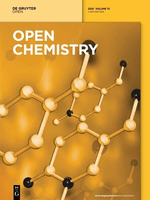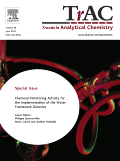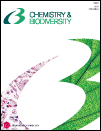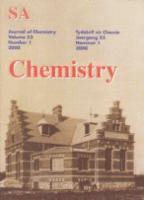
Pakistan Journal of Analytical & Environmental Chemistry
Scope & Guideline
Unveiling Insights into Analytical Methodologies
Introduction
Aims and Scopes
- Analytical Chemistry Techniques:
The journal publishes research utilizing a range of analytical techniques, such as spectrophotometry, chromatography, and electrochemical methods, to analyze chemical compounds in various matrices. - Environmental Chemistry and Pollution Studies:
A significant focus is on environmental chemistry, including studies on pollution sources, heavy metal contamination, and the environmental impact of industrial activities. - Green Chemistry and Sustainable Practices:
The journal encourages research on green chemistry principles, promoting sustainable practices in chemical synthesis and waste management. - Nanotechnology Applications:
Research on nanomaterials and their applications in environmental remediation, sensors, and pharmaceuticals is a core area of interest, reflecting the growing importance of nanotechnology in analytical chemistry. - Biochemistry and Pharmacology:
Studies on the biochemical properties of natural compounds, drug interactions, and the development of analytical methods for pharmaceuticals are also prominent.
Trending and Emerging
- Microfluidics and Automation in Analytical Chemistry:
There is a growing trend towards the development and application of microfluidic systems, which offer automation and miniaturization for enhanced analytical capabilities. - Bioremediation and Waste Management Techniques:
Research focused on biological methods for the remediation of contaminated environments, as well as innovative waste management solutions, is gaining prominence, reflecting a shift towards sustainable practices. - Health and Environmental Risk Assessments:
Studies assessing the health risks associated with chemical contaminants in food, water, and the environment are increasingly featured, highlighting the importance of public health in environmental chemistry. - Nanomaterials in Environmental Applications:
The application of nanomaterials for environmental remediation and as sensors for detecting pollutants is a rapidly emerging theme, showcasing the innovative intersection of nanotechnology and environmental science. - Green Synthesis of Chemicals and Materials:
There is an increasing focus on green synthesis methods for producing chemicals and materials, emphasizing the journal's commitment to sustainability and eco-friendly practices.
Declining or Waning
- Traditional Chemical Analysis Methods:
There appears to be a reduced emphasis on conventional chemical analysis methods in favor of more innovative and advanced techniques, reflecting a shift towards modern analytical approaches. - General Environmental Monitoring:
Broad studies on environmental monitoring without specific focus or innovative methodologies are becoming less common, as the journal seems to favor more targeted and impactful research. - Basic Agricultural Chemistry:
Research focused solely on basic agricultural chemistry, such as soil nutrient analysis, has diminished as the journal pivots towards more interdisciplinary studies involving environmental impacts and sustainability.
Similar Journals

Open Chemistry
Exploring New Horizons in Chemical ResearchOpen Chemistry, published by DE GRUYTER POLAND SP Z O O, is a distinguished peer-reviewed journal that has been serving the global chemistry community since its inception. With an ISSN of 2391-5420 and an E-ISSN also of 2391-5420, this open-access journal has been accessible to researchers and practitioners alike since 2015, ensuring a wide dissemination of high-quality research findings. Located in Germany, specifically at BOGUMILA ZUGA 32A STR, 01-811 WARSAW, MAZOVIA, POLAND, Open Chemistry aims to publish innovative research across various chemical disciplines, with special attention to miscellaneous chemistry and materials chemistry. It is currently ranked in the Q3 category for both fields as of 2023, reflecting its solid standing within the academic community, with specific ranks of 187/408 in General Chemistry and 153/317 in Materials Chemistry, corresponding to respective percentiles of 54 and 51. Open Chemistry not only enhances the accessibility of cutting-edge research but also serves as a vital resource for students, professionals, and scholars seeking to advance their knowledge in the rapidly evolving landscape of chemical sciences.

Journal of the Iranian Chemical Society
Pioneering Discoveries in the Heart of ChemistryThe Journal of the Iranian Chemical Society, published by SPRINGER, is a prominent academic journal dedicated to advancing the field of chemistry. With an ISSN of 1735-207X and an E-ISSN of 1735-2428, this quarterly journal has been contributing valuable research from 2006 to 2024. Situated in Germany, it serves as a vital platform for chemists and researchers to disseminate their findings, particularly within the miscellaneous chemistry category, where it ranks in the Q3 quartile for 2023. Despite its current lack of open access options, the journal maintains a solid presence in the academic community, evidenced by its Scopus ranking of #165 out of 408 in general chemistry and a commendable 59th percentile. The journal's objective aims to foster innovation and collaboration in chemical research, making it an essential resource for professionals and students keen on pioneering developments in the field. As a subscriber, you will gain insights into cutting-edge research that drives the future of chemistry.

Chemical Methodologies
Advancing Chemistry Through Innovative MethodologiesWelcome to Chemical Methodologies, a premier journal published by SAMI PUBLISHING CO-SPC, dedicated to advancing the field of chemistry through innovative research and methodologies. With an ISSN of 2645-7776 and an E-ISSN of 2588-4344, this journal provides a vital platform for researchers and scholars to share their findings in areas encompassing physical, theoretical, and organic chemistry. Despite its initial HIndex and quartile rankings still being established, the journal's evolving impact within the academic landscape is underscored by its Scopus Ranks, which place it in the 35th percentile for physical and theoretical chemistry and the 33rd percentile for organic chemistry. Since its inception in 2022, and continuing through 2024, Chemical Methodologies aims to foster collaboration and knowledge dissemination among academics and practitioners alike, bridging theoretical concepts and practical applications. This open-access platform enhances accessibility for researchers and students worldwide, ensuring that groundbreaking contributions to chemical science reach a broad audience.

TRAC-TRENDS IN ANALYTICAL CHEMISTRY
Advancing Knowledge in Analytical ChemistryTRAC - Trends in Analytical Chemistry is a prestigious journal published by Elsevier Science Ltd, situated in the Netherlands. With an impressive impact factor reflected in its Q1 rankings across three major categories—Analytical Chemistry, Environmental Chemistry, and Spectroscopy—this journal stands at the forefront of disseminating pioneering research and advancements in the field of analytical chemistry. Established in 1981, TRAC provides a comprehensive platform for researchers to share influential studies and insights related to the latest trends, methodologies, and technologies in analytical techniques. Recognized globally, the journal excels in fostering cross-disciplinary dialogue and innovation, making it an indispensable resource for academics, professionals, and students alike. Explore the latest issues to stay abreast of cutting-edge developments that shape the analytical sciences.

ANALYTICAL AND BIOANALYTICAL CHEMISTRY
Illuminating the Path of Chemical InnovationANALYTICAL AND BIOANALYTICAL CHEMISTRY, published by SPRINGER HEIDELBERG, is a leading international journal that serves as a vital platform for innovative research in the fields of analytical and bioanalytical chemistry. With an impressive impact factor and ranking in the Q2 category for both Analytical Chemistry and Biochemistry, the journal highlights key advancements and methodologies that drive the discipline forward. Established in 1996 and continuing vigorously into 2024, it has gained significant recognition with Scopus rankings placing it in the 83rd and 78th percentiles within its categories, underscoring its impact and relevance. The journal's commitment to open access facilitates widespread dissemination of critical scientific knowledge, making it an essential resource for researchers, professionals, and students dedicated to exploring the complexities of chemical analysis. With its base in Heidelberg, Germany, ANALYTICAL AND BIOANALYTICAL CHEMISTRY continues to inspire and influence the global research community.

CHEMISTRY & BIODIVERSITY
Exploring the Nexus of Chemistry and Life.CHEMISTRY & BIODIVERSITY is a prominent peer-reviewed journal published by Wiley-V C H Verlag GmbH, serving as a vital resource in the intersecting fields of biochemistry, bioengineering, and miscellaneous chemistry. With an ISSN of 1612-1872 and an E-ISSN of 1612-1880, this journal has established itself over its converged years from 2004 to 2024 as a platform for innovative research that contributes significantly to the understanding of chemical processes in biological systems. The journal's impact is reflected in its category quartiles, particularly notable in Q2 in Chemistry and various Q3 and Q4 rankings across multiple related disciplines. While it is not an open-access publication, it continues to attract a diverse readership, including researchers, academics, and students, who are keen to explore the complexities of chemistry's role in biodiversity. Through high-quality articles and comprehensive reviews, CHEMISTRY & BIODIVERSITY plays an essential role in fostering advances in molecular biology and biochemistry, positioning itself as a key contributor to the ongoing discourse in the life sciences.

SOUTH AFRICAN JOURNAL OF CHEMISTRY-SUID-AFRIKAANSE TYDSKRIF VIR CHEMIE
Exploring New Frontiers in Chemical ResearchSouth African Journal of Chemistry (Suid-Afrikaanse Tydskrif vir Chemie), published by Bureau Scientific Publications, is a pivotal open-access journal that has been disseminating groundbreaking research in the field of chemistry since its inception in 1996. With an ISSN of 0379-4350 and an E-ISSN of 1996-840X, this journal serves as a vital platform for researchers and professionals seeking to share their work and engage with the global chemistry community. Recognized for its significant contributions, the journal holds a Q3 quartile ranking in the miscellaneous chemistry category as of 2023 and ranks #216 out of 408 in General Chemistry according to Scopus. The South African Journal of Chemistry is dedicated to advancing knowledge in the discipline by publishing a wide array of articles, reviews, and studies that address pertinent chemical research and applications. With open access options available since 2000, it fosters a collaborative environment, ensuring that research is accessible to all, thereby enhancing the visibility and impact of chemists' work across South Africa and beyond.

JOURNAL OF THE CHEMICAL SOCIETY OF PAKISTAN
Pioneering Research for Tomorrow’s Chemical Challenges.JOURNAL OF THE CHEMICAL SOCIETY OF PAKISTAN is a premier academic journal published by the Chemical Society of Pakistan, focusing on advancing the field of chemistry through rigorous research and scholarship. Established in 1996, this journal aims to disseminate high-quality research articles, reviews, and insights pertaining to various subfields of chemistry, making substantial contributions to both local and international scientific communities. With a current impact factor placing it in the Q4 category, the journal continues to foster discussions on emerging trends and innovations within the discipline. Additionally, it holds a Scopus rank of #305 out of 408, highlighting its growing influence despite being positioned in the 25th percentile. Although it is not an open-access journal, it provides a crucial platform for researchers and professionals in Pakistan and worldwide. The JOURNAL OF THE CHEMICAL SOCIETY OF PAKISTAN serves as a valuable resource for students, educators, and industry professionals alike, facilitating the exchange of knowledge and promoting advancements in chemical sciences.

Canadian Journal of Chemistry
Exploring the Depths of Chemical ScienceWelcome to the Canadian Journal of Chemistry, a prominent publication dedicated to advancing the study of chemistry through original research and critical reviews. Published by Canadian Science Publishing, this journal has been a cornerstone of chemical research since its inception, covering a broad spectrum of topics within the field, including catalysis, organic chemistry, and general chemistry. With an ISSN of 0008-4042 and E-ISSN of 1480-3291, it provides a vital platform for researchers, professionals, and students to disseminate their findings and engage in scholarly discourse. Impact Factor is currently in development, with the journal classified in the Q4 category for catalysis and Q3 for miscellaneous chemistry fields, signifying its evolving contributions to the scientific community. The journal operates without an open access model, which ensures a rigorous peer-review process while maintaining subscription access for institutions and libraries. Located in Ottawa, Canada, the Canadian Journal of Chemistry continues to provide an invaluable resource for those dedicated to the scientific pursuit of chemistry, making significant strides in fostering interdisciplinary approaches and innovative research methodologies.

Chemistry Africa-A Journal of the Tunisian Chemical Society
Advancing Knowledge, Inspiring SolutionsChemistry Africa - A Journal of the Tunisian Chemical Society, published by SpringerNature, stands as a key platform for the dissemination of research in the dynamic fields of chemistry and its applications across Africa and beyond. With an ISSN of 2522-5758 and an E-ISSN of 2522-5766, this journal not only explores traditional chemistry topics but also delves into the intersections of catalysis, environmental chemistry, and physical theoretical chemistry, as reflected in its 2023 Scopus rankings, which place it in the Q3 quartile across multiple categories. Engaging researchers, professionals, and students, it aims to foster knowledge exchange and promote innovative solutions to contemporary challenges in chemistry. Although currently operating under traditional access, the journal's commitment to open scientific dialogue underlines its role in enhancing the visibility of African chemistry research. With been active since 2018 and set to converge through 2024, Chemistry Africa is vital for advancing regional and global scientific discourse.